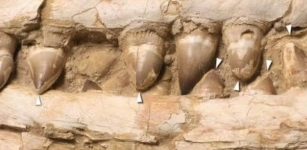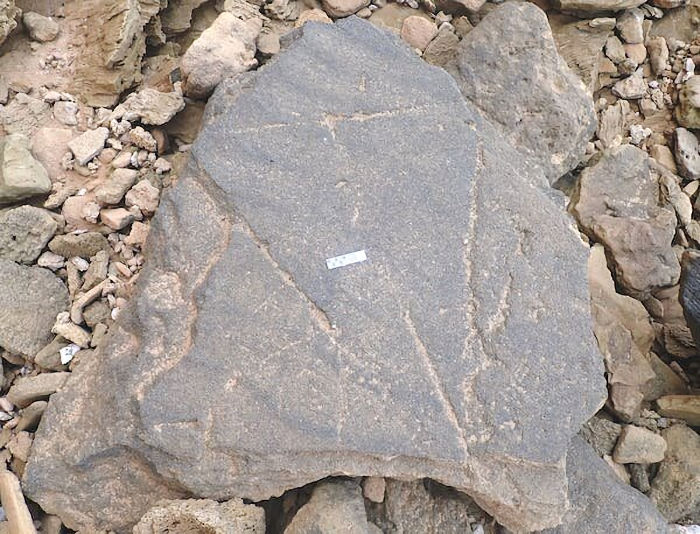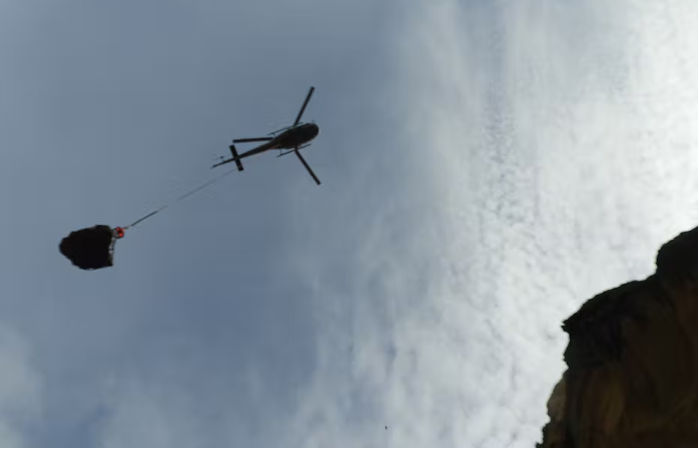Rock Stars: How A Group Of Scientists In South Africa Rescued A Rare 500 Kg Chunk Of Human History
AncientPages.com - Scientific breakthroughs can happen in the strangest ways and places. Alexander Fleming discovered penicillin because of mold growing on a Petri dish left out while he was on holiday. Chinese monks in the 9th century wanted to make a potion for immortality: instead, they discovered gunpowder.
Our own remarkable discovery happened on a rugged, remote stretch of coastline east of Still Bay on South Africa's Cape south coast. It was low tide, and three members of our ichnology team (people who study tracks and traces) were in search of newly exposed Pleistocene vertebrate tracksites in aeolianites (cemented dunes).
The larger of the two triangular geometric features (scale bar = 10 cm). Credit: Charles Helm
Ahead we saw a large rock that had tumbled down from the cliffs above. On its surface was a pattern of linear groove features in a large triangular shape, complete with an almost perfect bisecting groove. The sides of the triangle were close to a meter in length. After extensive research, we concluded that these grooves must have been made on a dune surface of unconsolidated sand by our human ancestors in the Middle Stone Age. The patterns are likely between 143,000 and 91,000 years old.
It was an important find in a significant place. Multiple lines of evidence on this coastline indicate that it's an area where our distant ancestors became truly modern, using fire as an engineering tool and creating abstract images.
But there was a problem. On a followup visit we found a smaller rock close by with a similar triangular feature. Subsequently, it was destroyed, likely by storm surges or high tides buffeting and overturning it. We knew that the larger rock inevitably awaited a similar fate if we did nothing. From our perspective this is one of the most important rocks in the world: it takes us back to our roots as a species and indicates the kind of "proto-art" we were capable of creating so long ago.
An unusual ‘rescue operation’ captured on video by Richard Webb.
The rock has subsequently been encased and placed on exhibit, with interpretive text panels. It joins similar exhibits in the museum; the grooves were an example of an ammoglyph, a term we had coined to describe a pattern created by humans in sand that is now evident in rock that has become cemented and then re-exposed.
Ascribing meaning to these geometric patterns made so long ago by our distant ancestors is not within our field of expertise. Still, we could not help but notice the resemblance of the triangular shape to a purported fertility symbol found in France and dated to around 38,000 years. Should the pattern on our rock represent the same motif, it would not be the first time that southern African discoveries had pushed back in time what has been viewed as an Upper Paleolithic Eurasian phenomenon.
A helicopter, net and a long-line cable - as well as a skilled pilot - were key to the ‘rescue’ operation. Credit: Richard Webb
Our research team now sleeps better at night, knowing that this priceless piece of our human heritage has been recovered and is available for others to see, appreciate and critique.
More to discover
Happily, there was an unexpected bonus. Beside the eroded remains of the second rock our ground crew noted a third rock surface which had not been evident previously. Near one edge it contained a distinct pair of grooves that met at an angle of 69 degrees, forming what may have been part of another triangular feature.
This is clearly an area we will return to repeatedly, in the hope that tidal forces may turn over other rocks before destroying them, and may give us an opportunity to glimpse—and perhaps recover—more ammoglyphs.
Written by Charles Helm, Research Associate, African Centre for Coastal Palaeoscience, Nelson Mandela University
and Jan Carlo De Vynck, Director and research fellow, African Centre for Coastal Palaeoscience, Nelson Mandela University, Nelson Mandela University
This article is republished from The Conversation under a Creative Commons license. Read the original article.
More From Ancient Pages
-
 ‘Sea Monsters’ Were Real Millions Of Years Ago: New Fossils Tell About Their Rise And Fall
Featured Stories | Oct 8, 2022
‘Sea Monsters’ Were Real Millions Of Years Ago: New Fossils Tell About Their Rise And Fall
Featured Stories | Oct 8, 2022 -
 Giants Of Monte Prama – Mysterious Ancient Statues With Unearthly Eyes
Artifacts | Aug 31, 2018
Giants Of Monte Prama – Mysterious Ancient Statues With Unearthly Eyes
Artifacts | Aug 31, 2018 -
 DNA Reveals Poland’s First Kings May Have Scottish Origin – New Study Challenges Existing Myths
DNA | Jun 20, 2025
DNA Reveals Poland’s First Kings May Have Scottish Origin – New Study Challenges Existing Myths
DNA | Jun 20, 2025 -
 Mysterious City Lost In The Sands And Its Hidden Treasures
Ancient Mysteries | May 21, 2018
Mysterious City Lost In The Sands And Its Hidden Treasures
Ancient Mysteries | May 21, 2018 -
 World-Famous Temple Of Bel In Palmyra, Syria – Digitally Reconstructed
News | Aug 22, 2020
World-Famous Temple Of Bel In Palmyra, Syria – Digitally Reconstructed
News | Aug 22, 2020 -
 Secrets Of Ancient Ivory Manikins Revealed
Archaeology | Nov 28, 2019
Secrets Of Ancient Ivory Manikins Revealed
Archaeology | Nov 28, 2019 -
 Bible And Book Of Enoch Reveal Why Ancient Giant Bones Are Missing
Ancient Mysteries | Jul 21, 2018
Bible And Book Of Enoch Reveal Why Ancient Giant Bones Are Missing
Ancient Mysteries | Jul 21, 2018 -
 Viking Grave And Sword Discovered In Norwegian Garden
Archaeology | Jul 3, 2023
Viking Grave And Sword Discovered In Norwegian Garden
Archaeology | Jul 3, 2023 -
 Chauvet-Pont d’Arc Cave And Surrounding Landscape – What Did The Ancient Artists See?
Archaeology | Apr 29, 2021
Chauvet-Pont d’Arc Cave And Surrounding Landscape – What Did The Ancient Artists See?
Archaeology | Apr 29, 2021 -
 2,000-Year-Old Roman Sandal With Nails Found In Germany
Archaeology | Jun 28, 2024
2,000-Year-Old Roman Sandal With Nails Found In Germany
Archaeology | Jun 28, 2024 -
 Mogao Grottoes, Dunhuang, China – Fascinating Statues, Manuscripts And Wall Paintings
Featured Stories | Dec 15, 2015
Mogao Grottoes, Dunhuang, China – Fascinating Statues, Manuscripts And Wall Paintings
Featured Stories | Dec 15, 2015 -
 Green Comet Last Seen By The Neanderthals 50,000 Years Ago May Be Visible To The Naked Eye This Week
Archaeoastronomy | Jan 9, 2023
Green Comet Last Seen By The Neanderthals 50,000 Years Ago May Be Visible To The Naked Eye This Week
Archaeoastronomy | Jan 9, 2023 -
 Human Activities In The Year 1300 Impacted Earth’s Atmosphere More Than Previously Known
Archaeology | Oct 9, 2021
Human Activities In The Year 1300 Impacted Earth’s Atmosphere More Than Previously Known
Archaeology | Oct 9, 2021 -
 Why Are There No Unicorn Fossils In A Museum?
Archaeology | Mar 17, 2023
Why Are There No Unicorn Fossils In A Museum?
Archaeology | Mar 17, 2023 -
 Mysterious Books From The Unknown And ‘Impossible’ Coincidences
Featured Stories | Dec 30, 2020
Mysterious Books From The Unknown And ‘Impossible’ Coincidences
Featured Stories | Dec 30, 2020 -
 Catherine De Medici – Queen Of France Supported Nostradamus, Was Suspected Of Poisoning And Blamed For Horrible Massacre
Featured Stories | Dec 17, 2018
Catherine De Medici – Queen Of France Supported Nostradamus, Was Suspected Of Poisoning And Blamed For Horrible Massacre
Featured Stories | Dec 17, 2018 -
 On This Day In History: Siege of Jerusalem: Titus And His Legions Breach The Middle Wall Of The City – On June 5, 70 CE
News | Jun 5, 2016
On This Day In History: Siege of Jerusalem: Titus And His Legions Breach The Middle Wall Of The City – On June 5, 70 CE
News | Jun 5, 2016 -
 Scientists Say Dinosaurs Could Be The Reason Humans Can’t Live For 200 Years
Featured Stories | Jan 8, 2024
Scientists Say Dinosaurs Could Be The Reason Humans Can’t Live For 200 Years
Featured Stories | Jan 8, 2024 -
 New Mexico Mammoths Offer Evidence Of Early Humans In North America Much Earlier Than Previously Thought
Archaeology | Aug 1, 2022
New Mexico Mammoths Offer Evidence Of Early Humans In North America Much Earlier Than Previously Thought
Archaeology | Aug 1, 2022 -
 Genghis Khan Has 16 Million Relatives – You Could Be One Of Them
Ancient History Facts | Feb 3, 2018
Genghis Khan Has 16 Million Relatives – You Could Be One Of Them
Ancient History Facts | Feb 3, 2018


